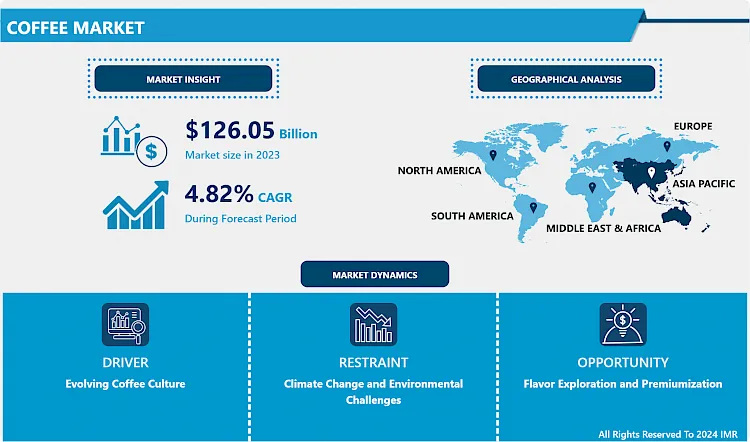Coffee Market Synopsis
Coffee Market Size Was Valued at USD 126.05 Billion in 2023, and is Projected to Reach USD 192.55 Billion by 2032, Growing at a CAGR of 4.82% From 2024-2032.
Coffee is a brewed beverage made from roasted coffee beans, the seeds of berries from the Coffea plant. It is enjoyed worldwide for its stimulating effects due to caffeine content. Typically served hot or iced, coffee is a popular drink consumed for its taste, aroma, and energizing properties.
- The coffee industry is expanding as the youth, particularly in India, Italy, the United States, China, Japan, and the Philippines, increasingly embrace coffee as a revitalizing beverage. Moreover, the rise in disposable income along with urbanization is the main driver behind the expansion of the coffee market. Conversely, the multiple health advantages of drinking coffee, including lowering the chance of diabetes, aiding in fat burning, and providing increased energy from caffeine boosts, are also propelling market expansion.
- Shoppers are increasingly opting for organic or plant-based coffee to support a healthy lifestyle. Therefore, major players are involved in product innovations to secure a more robust presence in the market. A key factor contributing to market expansion is the fast-paced lifestyles, resulting in a rise in the popularity of coffee chains among patrons who prefer their coffee while on the move.
- Shoppers seek high-end items that highlight excellence. They gravitate towards premium coffee shops that provide superior coffee quality, a crucial element for returning customers. Innovations in technology, safety protocols, and machine-operated food processing facilities are expected to be crucial in driving the demand for coffee in the years ahead.


Coffee Market Trend Analysis
Evolving Coffee Culture
- The transformation of coffee culture emerges as a pivotal force propelling the expansion of the coffee market. Initially valued for its stimulating effects, coffee has evolved into a cultural phenomenon that molds social dynamics, consumer inclinations, and market trajectories. This evolution is epitomized by the ascendancy of specialty coffee, characterized by its focus on superior-grade beans, artisanal brewing techniques, and distinct flavor profiles. This premiumization trend has fostered the emergence of specialty coffee outlets, artisanal roasters, and coffee-centric gatherings worldwide, catering to discerning consumers seeking refined coffee experiences.
- Coffee culture has interwoven itself with broader lifestyle trends such as wellness, sustainability, and ethical consumption. Consumers increasingly gravitate towards coffee products that resonate with their values, including organically sourced, fair trade, and socially responsible options.
- The coffee culture fuels innovation across product development, packaging, and marketing domains, fueling market expansion and diversification. From groundbreaking brewing methodologies to inventive flavor blends, the evolving coffee culture continues to shape the coffee market landscape, presenting a spectrum of experiences and avenues for industry stakeholders to connect with consumers on a profound level.
Flavor Exploration and Premiumization
- Flavor exploration and premiumization stand as promising avenues for the coffee market's expansion. As consumers increasingly seek new and refined tastes, there emerges a heightened demand for diverse flavor profiles that elevate the coffee-drinking experience. This trend corresponds with the growing appeal of specialty and gourmet coffee, where individuals pursue superior-quality beans, unique blends, and artisanal brewing techniques.
- Coffee producers and retailers are seizing this opportunity by offering an extensive array of flavor options, encompassing single-origin beans, exotic blends, and flavored coffees enriched with ingredients like vanilla, caramel, and spices. Moreover, the proliferation of specialty coffee shops and boutique roasters provides platforms for enthusiasts to delve into and appreciate an array of flavor nuances through curated tasting events, coffee samplings, and educational initiatives.
- Premiumization within the coffee sector entails the introduction of upscale products and experiences that command higher price points, catering to consumers seeking superior quality, exclusivity, and craftsmanship. This includes offerings such as limited-edition roasts, luxurious packaging, and specialized brewing apparatuses, amplifying the perceived value and prestige associated with the coffee brand. Overall, flavor exploration and premiumization present lucrative opportunities for companies to distinguish themselves, captivate discerning audiences, and foster revenue growth amid the competitive coffee landscape.
Coffee Market Segment Analysis:
Coffee Market Segmented on the basis of Type, Nature, and Distribution Channel.
By Type, Ground Coffee segment is expected to dominate the market during the forecast period
- The ground coffee segment is poised to maintain its dominance in the coffee market due to several factors. Ground coffee offers convenience and adaptability, appealing to a broad spectrum of consumers seeking a straightforward brewing experience without the need for specialized equipment. Unlike whole-bean coffee, ground coffee eliminates the necessity for grinding, making it accessible to individuals without dedicated coffee-making tools.
- Ground coffee caters to diverse brewing preferences, including drip, French press, and espresso methods, accommodating a variety of tastes and requirements. This versatility enhances its attractiveness to consumers valuing ease of use while preserving flavor. Ground coffee is widely available across retail channels, including supermarkets, specialty stores, and online platforms, ensuring broad market penetration and accessibility for consumers globally.
- Additionally, ongoing product innovation within the ground coffee segment, characterized by the introduction of new flavors, blends, and packaging options, caters to evolving consumer demands and sustains interest and loyalty. These aspects collectively reinforce the segment's prominence in the competitive coffee market landscape.
By Nature, Conventional segment is expected to dominate the market during the forecast period
- The conventional segment of the coffee market is poised to maintain its dominance for several reasons. Conventional farming practices are currently the most prevalent and established methods in the industry. Many coffee growers worldwide rely on conventional techniques, employing synthetic fertilizers, pesticides, and herbicides to optimize yields and safeguard crops against pests and diseases. These approaches often result in increased productivity and reduced production costs, rendering conventional coffee more accessible and cost-effective for consumers.
- Conventional coffee production typically operates on a larger scale, enabling economies of scale and enhanced efficiency throughout the production, processing, and distribution processes. Consequently, conventional coffee products tend to hold a competitive edge in terms of pricing and availability compared to organic counterparts.
- Despite the growing interest in organic and sustainable offerings, conventional coffee remains the predominant choice in global production and consumption. As a result, the conventional segment is expected to retain its market dominance due to well-established supply chains, widespread availability, and competitive pricing relative to organic alternatives.
Coffee Market Regional Insights:
Asia Pacific is Expected to Dominate the Market Over the Forecast period
- Asia Pacific is anticipated to emerge as a dominant force in the coffee market due to several compelling factors. The region is witnessing rapid urbanization and economic growth, resulting in a burgeoning middle class with greater disposable incomes. Consequently, a larger portion of consumers in Asia Pacific can afford coffee products, thereby boosting demand for both traditional and specialty coffee offerings.
- There is a noticeable proliferation of coffee culture across many countries in the Asia Pacific region, driven by increasing exposure to Western lifestyles and preferences. This cultural shift is evident in the rising number of coffee shops, cafes, and specialty roasters popping up in major urban centers, catering to the evolving tastes and desires of consumers.
- Asia Pacific boasts some of the world's largest coffee-producing nations, including Vietnam and Indonesia, which significantly contribute to global coffee output. The geographical proximity to these key coffee-growing regions facilitates easier access to fresh coffee beans, thereby supporting the development of local coffee industries and fostering a robust supply chain. the growing social appeal and status associated with coffee consumption further propel its popularity in Asia Pacific, solidifying the region's position as a dominant player in the global coffee market in the foreseeable future.
Coffee Market Top Key Players:
- The J.M. Smucker Company (US)
- Keurig Green Mountain (US)
- Peet's Coffee (US)
- Dunkin' Brands Group (US)
- Coffee Holding Co., Inc. (US)
- Kraft Heinz Company (US)
- Tootsie Roll Industries (US)
- Community Coffee Company (US)
- Trader Joe's (US)
- Mondelez International (US)
- McCafé (US)
- Tchibo (Germany)
- NKG (Neumann Kaffee Gruppe) (Germany)
- Melitta Group (Germany)
- D.E Master Blenders 1753 (Netherlands)
- Nestlé (Switzerland)
- JAB Holding Company (Luxembourg)
- Luigi Lavazza S.p.A. (Italy)
- Illycaffè S.p.A. (Italy)
- Massimo Zanetti Beverage Group (Italy)
- illy Group (Italy)
- Costa Coffee (UK)
- Tata Consumer Products (India)
- Strauss Group (Israel), and Other Major Players.
Key Industry Developments in the Coffee Market:
-
In March 2024, Nespresso announced the launch of its new eco-friendly coffee portfolio, featuring fully traceable green coffee beans sourced sustainably. With this initiative, Nespresso aimed to meet the rising demand for organic and ethically sourced coffee while expanding its market reach and boosting sales. The new range underscored the brand's commitment to sustainability and compliance with eco-friendly measures, reflecting its dedication to responsible and ethical practices.
-
In February 2024, Seattle, WA Starbucks announced plans to expand its global footprint with 500 additional stores by the end of 2025. The move reflects the company’s commitment to meeting the rising demand for coffee in key markets like China and India. This expansion underscores Starbucks’ strategy to strengthen its presence in regions with significant growth potential for coffee consumption.
|
Coffee Market |
|||
|
Base Year: |
2023 |
Forecast Period: |
2024-2032 |
|
Historical Data: |
2017 to 2023 |
Market Size in 2023: |
USD 126.05 Bn. |
|
Forecast Period 2024-32 CAGR: |
4.82 % |
Market Size in 2032: |
USD 192.55 Bn. |
|
Segments Covered: |
By Type |
|
|
|
By Nature, |
|
||
|
By Distribution Channel |
|
||
|
By Region |
|
||
|
Key Market Drivers: |
|
||
|
Key Market Restraints: |
|
||
|
Key Opportunities: |
|
||
|
Companies Covered in the Report: |
|
||
INTRODUCTION
RESEARCH OBJECTIVES
RESEARCH METHODOLOGY
RESEARCH PROCESS
SCOPE AND COVERAGE
Market Definition
Key Questions Answered
MARKET SEGMENTATION
EXECUTIVE SUMMARY
MARKET OVERVIEW
GROWTH OPPORTUNITIES BY SEGMENT
MARKET LANDSCAPE
PORTER’S FIVE FORCES ANALYSIS
Bargaining Power Of Supplier
Threat Of New Entrants
Threat Of Substitutes
Competitive Rivalry
Bargaining Power Among Buyers
INDUSTRY VALUE CHAIN ANALYSIS
MARKET DYNAMICS
Drivers
Restraints
Opportunities
Challenges
MARKET TREND ANALYSIS
REGULATORY LANDSCAPE
PESTLE ANALYSIS
PRICE TREND ANALYSIS
PATENT ANALYSIS
TECHNOLOGY EVALUATION
MARKET IMPACT OF THE RUSSIA-UKRAINE WAR
Geopolitical Market Disruptions
Supply Chain Disruptions
Instability in Emerging Markets
ECOSYSTEM
COFFEE MARKET BY TYPE (2017-2032)
COFFEE MARKET SNAPSHOT AND GROWTH ENGINE
MARKET OVERVIEW
WHOLE BEAN COFFEE
Introduction And Market Overview
Historic And Forecasted Market Size in Value (2017 – 2032F)
Historic And Forecasted Market Size in Volume (2017 – 2032F)
Key Market Trends, Growth Factors and Opportunities
Geographic Segmentation Analysis
GROUND COFFEE
INSTANT COFFEE
COFFEE PODS AND CAPSULES
COFFEE MARKET BY NATURE (2017-2032)
COFFEE MARKET SNAPSHOT AND GROWTH ENGINE
MARKET OVERVIEW
CONVENTIONAL
Introduction And Market Overview
Historic And Forecasted Market Size in Value (2017 – 2032F)
Historic And Forecasted Market Size in Volume (2017 – 2032F)
Key Market Trends, Growth Factors And Opportunities
Geographic Segmentation Analysis
ORGANIC
COFFEE MARKET BY DISTRIBUTION CHANNEL (2017-2032)
COFFEE MARKET SNAPSHOT AND GROWTH ENGINE
MARKET OVERVIEW
ON-TRADE
Introduction And Market Overview
Historic And Forecasted Market Size in Value (2017 – 2032F)
Historic And Forecasted Market Size in Volume (2017 – 2032F)
Key Market Trends, Growth Factors And Opportunities
Geographic Segmentation Analysis
OFF-TRADE
COMPANY PROFILES AND COMPETITIVE ANALYSIS
COMPETITIVE LANDSCAPE
Competitive Positioning
Coffee Market Share By Manufacturer (2023)
Industry BCG Matrix
Heat Map Analysis
Mergers & Acquisitions
THE J.M. SMUCKER COMPANY (US)
Company Overview
Key Executives
Company Snapshot
Role of the Company in the Market
Sustainability and Social Responsibility
Operating Business Segments
Product Portfolio
Business Performance (Production Volume, Sales Volume, Sales Margin, Production Capacity, Capacity Utilization Rate)
Key Strategic Moves And Recent Developments
SWOT Analysis
KEURIG GREEN MOUNTAIN (US)
PEET'S COFFEE (US)
DUNKIN' BRANDS GROUP (US)
COFFEE HOLDING CO., INC. (US)
KRAFT HEINZ COMPANY (US)
TOOTSIE ROLL INDUSTRIES (US)
COMMUNITY COFFEE COMPANY (US)
TRADER JOE'S (US)
MONDELEZ INTERNATIONAL (US)
MCCAFÉ (US)
TCHIBO (GERMANY)
NKG (NEUMANN KAFFEE GRUPPE) (GERMANY)
MELITTA GROUP (GERMANY)
D.E MASTER BLENDERS 1753 (NETHERLANDS)
NESTLÉ (SWITZERLAND)
JAB HOLDING COMPANY (LUXEMBOURG)
LUIGI LAVAZZA S.P.A. (ITALY)
ILLYCAFFÈ S.P.A. (ITALY)
MASSIMO ZANETTI BEVERAGE GROUP (ITALY)
ILLY GROUP (ITALY)
COSTA COFFEE (UK)
TATA CONSUMER PRODUCTS (INDIA)
STRAUSS GROUP (ISRAEL)
GLOBAL COFFEE MARKET BY REGION
OVERVIEW
NORTH AMERICA
Key Market Trends, Growth Factors And Opportunities
Key Manufacturers
Historic And Forecasted Market Size By Type
Historic And Forecasted Market Size By Nature
Historic And Forecasted Market Size By Distribution Channel
Historic And Forecasted Market Size By Country
USA
Canada
Mexico
EASTERN EUROPE
Key Market Trends, Growth Factors And Opportunities
Key Manufacturers
Historic And Forecasted Market Size By Segments
Historic And Forecasted Market Size By Country
Russia
Bulgaria
The Czech Republic
Hungary
Poland
Romania
Rest Of Eastern Europe
WESTERN EUROPE
Key Market Trends, Growth Factors And Opportunities
Key Manufacturers
Historic And Forecasted Market Size By Segments
Historic And Forecasted Market Size By Country
Germany
United Kingdom
France
The Netherlands
Italy
Spain
Rest Of Western Europe
ASIA PACIFIC
Key Market Trends, Growth Factors And Opportunities
Key Manufacturers
Historic And Forecasted Market Size By Segments
Historic And Forecasted Market Size By Country
China
India
Japan
South Korea
Malaysia
Thailand
Vietnam
The Philippines
Australia
New-Zealand
Rest Of APAC
MIDDLE EAST & AFRICA
Key Market Trends, Growth Factors And Opportunities
Key Manufacturers
Historic And Forecasted Market Size By Segments
Historic And Forecasted Market Size By Country
Turkey
Bahrain
Kuwait
Saudi Arabia
Qatar
UAE
Israel
South Africa
SOUTH AMERICA
Key Market Trends, Growth Factors And Opportunities
Key Manufacturers
Historic And Forecasted Market Size By Segments
Historic And Forecasted Market Size By Country
Brazil
Argentina
Rest of South America
INVESTMENT ANALYSIS
ANALYST VIEWPOINT AND CONCLUSION
Recommendations and Concluding Analysis
Potential Market Strategies
|
Coffee Market |
|||
|
Base Year: |
2023 |
Forecast Period: |
2024-2032 |
|
Historical Data: |
2017 to 2023 |
Market Size in 2023: |
USD 126.05 Bn. |
|
Forecast Period 2024-32 CAGR: |
4.82 % |
Market Size in 2032: |
USD 192.55 Bn. |
|
Segments Covered: |
By Type |
|
|
|
By Nature, |
|
||
|
By Distribution Channel |
|
||
|
By Region |
|
||
|
Key Market Drivers: |
|
||
|
Key Market Restraints: |
|
||
|
Key Opportunities: |
|
||
|
Companies Covered in the Report: |
|
||








